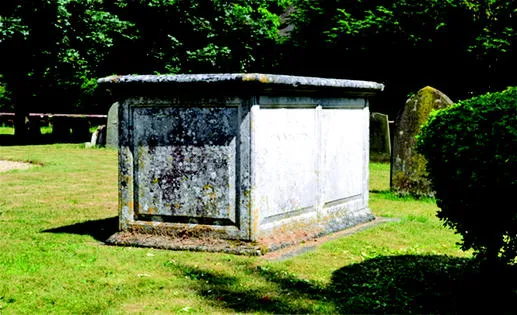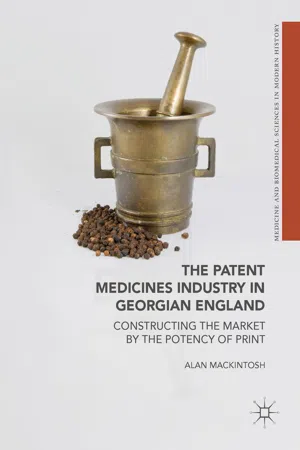Prologue: An Obscured History
The imposing tomb of
John Newbery , far larger than other graves and stones nearby, dominates the picturesque churchyard of Waltham St. Lawrence, Berkshire (Fig.
1.1). As a successful London publishing bookseller, John Newbery (1713–1767) was a close friend of
Oliver Goldsmith ,
Samuel Johnson and many other literary figures, as well as an employer of
Tobias Smollett . Today he is well known as the father of children’s publishing, with the
John Newbery Medal being awarded each year by the American Library Association for the most distinguished US children’s book. However, the tomb reveals that Newbery was more than just an innovative London bookseller.
As might be expected, the south and north faces of the tomb commemorate his publishing activities, with some of the inscriptions probably added at a later date. But examination of the smaller west face reveals a different facet of John Newbery, and also a great deal about the prejudices of later generations. The west face, unlike the north and south faces, has not been recently cleaned, leaving its inscription partly obscured by lichen. Closer inspection shows that the wording is a sixteen-line eulogy extolling Newbery’s virtues. The middle seven lines read:
Sagacity, that discerned, and
Skill, that introduced
The most powerful discovery
In the annals of medicine.
The humble wisdom that taught,
And still teaches, moral lessons
To the rising generation.
‘The most powerful discovery in the annals of medicine’, a truly breathtaking claim, refers to the most successful patent medicine in Georgian England, Dr. James’s Fever Powder . Newbery was the wholesaler and part-owner of this powder. On the tomb, this activity is placed ahead of, and expressed in more superlative terms than, Newbery’s children’s publishing, which taught ‘moral lessons to the rising generation’. The words on any tomb are not a spur-of-the-moment impression of little consequence; they reflect the considered opinion of at least some family members or contemporaries on the life of the deceased. And for John Newbery, this opinion was that selling a patent medicine was as important as, or perhaps more important than, publishing children’s books.
Newbery’s will, written just three months before his death, suggests that the medicines were the most profitable aspect of his business. 1 An indication from his will of the importance of patent medicines to Newbery and his associates is the three friends who were left money for a commemorative ring. They were: Dr. Robert James , a physician, writer of a well-known medical dictionary and inventor of the eponymous fever powder, Thomas Greenough , an apothecary and business collaborator, and Benjamin Collins , publishing bookseller, banker and printer of the Salisbury Journal . The physician, apothecary and bookseller, all prominent in their vocations, had one thing in common: they were medicine owners who had patented at least one medicine each and seven between them. The inscription on the tombstone was not a mistake: patent medicines were a substantial part of Newbery’s business.
So why has this inscription, which tells us so much about John Newbery , escaped the scrubbing brush in contrast to the wording on the rest of the tomb? The probable answer reflects a common modern attitude to Georgian patent medicines, an attitude which is so powerful that it can trump the available evidence. It seems that the restorers wanted to reduce awareness of Newbery’s involvement with patent medicines, even though his medicine interests have been well documented, but underestimated, by biographers. 2 They did not regard it as a respectable activity for a revered eighteenth-century publishing bookseller, especially one associated with children’s books. A blind eye had to be turned. By contrast, John Newbery’s relatives and friends two-and-a-half centuries earlier had wished to herald that involvement.
The inscription provides a brief glimpse of an organised Georgian industry which was regarded as being perfectly respectable by many of its participants, and by their friends and relatives, despite the opposition from some members of the medical professions. But later generations hid Georgian patent medicines away or portrayed them with condescending humour. Like deciphering the words obscured by lichen on the west face of Newbery’s tomb, we need to find the authentic picture of Georgian patent medicines underneath the prejudices of later centuries. Only then can the position of these owned, secret, medicines in the medical market be properly assessed, and the full structure of Georgian healthcare be allowed to emerge. That is the object of this book.
Patent Medicines in the Medical Market
Few topics of the eighteenth century have been so vulnerable as patent medicines to the hostile judgements of later generations. The supposed dishonesty and avarice of their producers and the assumed ignorance of their consumers can still provide amusement today, with words such as ‘crooks’, ‘quacks ’ and ‘fraud’ being frequently employed. 3 The very success of Georgian patent medicines led to this historical aberration: a minor role could have been ignored, but their success was a threat. Many orthodox medical practitioners of that period sought to diminish this commercial and professional challenge in the crowded medical market by questioning the safety of the medicines, and by describing any apparent benefits as a delusion. Then the later medical reformers of the mid-nineteenth century needed to brand them as a menace to the community in order to establish a separate and unified medical profession, the sole guardian of the public interest. Medical care that was not under the control of the profession had to be immoral and inconsequential.
In recent decades, historians have adopted a more balanced approach to alternative Georgian healthcare, with the medical market as the preferred framework. Orthodox medicine was only one of the market’s components, and the consumer could choose freely between them in the largely unregulated medical world of the British Isles. Patent medicines are readily observable in this market, but they have been largely conceived as a constituent, and indeed an accessible illustration, of irregular practice. 4 They provided historians with access to ‘quackery’, but have rarely been considered as a separate entity. This study of patent medicines demonstrates , in contrast, that the ownership, distribution, retailing and promotion of patent medicines was a stable , successful, and mostly honest industry, which can be recognised as such from the middle of the eighteenth century. Much of this industry was run by tradesmen , specialised medicine wholesalers, chemists , regular medical practitioners, newspaper printers , booksellers and druggists , and it was distinct both from irregular practice and from orthodox medicine. As a result, the structure of late Georgian healthcare needs to be redrawn with the patent medicines industry regarded as a separate entity which overlapped with the care provided by both regular and irregular practitioners, but had its own specific character.
This exploration of patent medicines goes deeper than a revision of the overall configuration of the medical market: it provides the functional detail for an important section of that market. Jenner and Wallis have pointed out that the term ‘medical marketplace’ has been used to avoid precise investigation of the market. 5 This book brings the market back into the medical market by approaching the ownership and sale of patent medicines as a commercial activity which supplied a form of healthcare. Commercial success depended on satisfied consumers, so this approach then directs attention to the health benefits of patent medicines. In contrast, many histories of Georgian medicine have come from the opposite direction, exploring some aspect of healthcare and then adding in the commercial background if possible. Thus, we have surprisingly little detail on how the medical market, a commercially driven enterprise, functioned across the country. This book exposes, for the first time, some of the business principles and practices throughout England of a major section of the medical market.
Revealing these business practices shines a spotlight on the use of the printed word in promoting, and ensuring the effectiveness, of patent medicines. With a few exceptions,...


